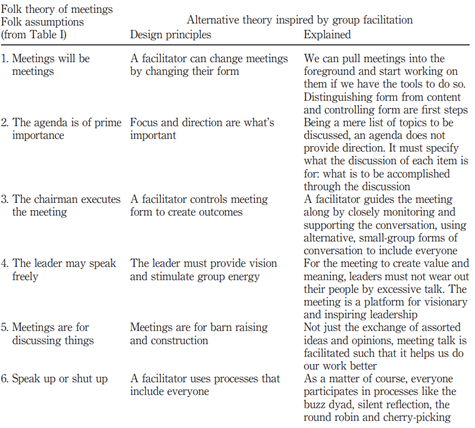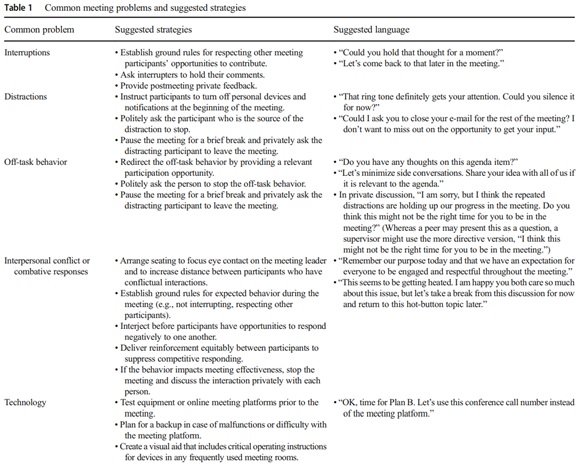Organize and lead an effective work meeting: 8 tips from scientific research
How to organize an effective business meeting knowing that this is part of one of the most strategic tasks within a company?
Here are our tips on how to organize an effective work meeting:
1 – Know the cost of your meetings
2 – Decide if you really need to organize a new meeting
3 – Define with extreme precision the purpose and duration of the meeting
4 – Invite the right people
5 – Animate effective, motivating meetings and facilitating team cohesion
6 – Manage conflict effectively and prevent counterproductive behavior
7 – Take into account linguistic and intercultural aspects
8 – Evaluate and improve the efficiency of your meetings
To answer these questions, I analyzed for you the scientific literature on this subject to enable you to achieve two main objectives.
First, allow you to have reliable and up-to-date information.
Second, offer you effective advice.
Improving the management and efficiency of meetings at work is a big challenge because, as research shows, the cost of unproductive business meetings is impressive from both a human and a financial point of view.
The OECD survey (2017) indicates that the most common obstacle to productivity was unnecessary meetings (57% of respondents).
But what are the reasons for this inefficiency?
What is certain is that one of the reasons is the mismanagement of time before, during, and after the meetings because as Romano & Nunamaker (2001) show, time is not used effectively during meetings.
In this article, you will discover tips from scientific research on how to effectively organize a team meeting at work.
For each point, I will propose operational advice to improve the results of your meetings.
Find out without delay the ultimate guide on how to organize and lead an effective business meeting.
1 – Know the cost of your meetings
What is the cost of a meeting within your company?
Few CEOs and business leaders are able to answer this question because organizing a meeting is often a simple habit.
Why do few leaders know the true value of their meetings?
Simply because they do not have reliable tools to measure the return on investment of each meeting.
Calculating the return on investment requires taking into account the financial dimension and the human dimension of the company.
The financial cost is probably the easiest to calculate, whereas the human impact on employees often requires further analysis.
To begin to evaluate the current cost of your meetings, I propose you to rely on the work of Rogelberg, Rhoades & Schott (2011) who propose a three-step process:
Step 1: Assess the company’s current investment in the meetings. These authors suggest making a partial estimate based on the annual salary of each participant and calculating the cost according to the time spent in each meeting.
Step 2: Evaluate the return on investment for each meeting to identify meetings that do not meet the needs of the company and collaborators. These meetings must be eliminated.
Step 3: Formulate and implement a change strategy that focuses on three factors:
- feedback on performance during a meeting
- training and leadership development in organizing and facilitating a meeting
- the establishment of a strategic meeting model in the company’s culture facilitating the awareness of human and financial investment for the company for this kind of practice
Following these steps is important to have a first understanding of the effectiveness of your work meetings. A closer audit within your company with a time management coach can help you get even more accurate data.
Operational tip: Set short-term goals and move on right away.
Following and implementing the previous 3 steps is a task that requires a lot of time and resources.
On the other hand, I propose to identify 2 or 3 actions that you can put in place immediately over a week or a month.
Plan and run them without trying to be perfect and waiting for the perfect time.
Doing this will allow you to start a gradual process of change that will be more realistic and simple to implement. In addition, by proceeding in small steps, you will reduce the resistance to changes in your structure.
After conducting these steps, you will have a first understanding of your room for improvement in organizing an effective meeting within your company.
Now, I propose you move to the second step, namely, decide if you really need to organize a new meeting.
2 – Decide if you really need to organize a new meeting
Before scheduling a new meeting, you should think about other less expensive alternatives that will allow you to achieve what you want to accomplish through the meeting.
In this sense, Koshy, Liu, Whitehurst, Gundogan & Al Omran (2017) propose to privilege other forms of communication if there is no real need to schedule a new meeting.
Depending on your needs, other forms of communication may be more appropriate to accomplish your goals.
Here are some questions to ask yourself before scheduling a new meeting.
Can we communicate this message faster, easier, and more efficiently and at a lower cost without organizing a new meeting?
Is what we want really linked to an important goal for our company or are we planning a new meeting just by habit?
What will happen if this meeting is not organized?
Do we need to resolve a conflict within the team?
Do we need to brainstorm?
Do we want to strengthen cohesion within the teams?
Do we need to help our employees be more motivated?
Operational tip: think about creative and alternative ways to work meetings.
Now that you have partial knowledge of the human and financial cost of your meetings, you need to free yourself from your old habits.
Instead of scheduling a new meeting, identify new ways to accomplish tasks that do not require the simultaneous participation of a large number of collaborators.
Ask yourself the following questions:
What unusual place could allow us to communicate our message more effectively?
Which supports are the most adapted to gain efficiency and share our message quickly?
What new technology could help us reduce the number of meetings?
Who are the most creative employees of our company?
What do companies that have already succeeded in reducing the frequency of their meetings do?
What internal procedures are already effective and how can they be improved to save time?
Answering these questions will significantly reduce the number of unnecessary meetings and increase productivity.
Now, I propose you move on to the third step, namely, define precisely the purpose and duration of your next meeting.
3 – Define with extreme precision the purpose and duration of the meeting
Now that you are sure of the value of holding a new meeting, you need to identify the main purpose of this meeting.
Doing this is the first step to organizing and conducting an effective business meeting.
A successful meeting requires each participant to have an understanding of the purpose of the meeting.
In this sense (Barker, 2011; López-Fresno & Grandes, 2010; López-Fresno, 2011) show that the agenda provides a structure for the meeting and, if properly prepared and ethical (there are no hidden agendas, hidden topics, or objectives) and distributed in advance, it specifies the actual objectives of the meeting, what is expected of each participant and what available information that is important for every person or group of people.
This is important because acting differently would have a negative impact on the relationships within the company. In this sense (López-Fresno & Grandes, 2010, Nixon & Littlepage, 1992) show that hidden agendas, topics, or objectives reduce trust, cooperation, and cohesion of the group, with a negative impact on organizational culture.
While according to Leach & al. (2009) a written agenda and the finalization of all planned elements positively impact the perception of a meeting.
Allen, Sands, Mueller, Frear, Mara Mudd & Rogelberg (2012) show that employees value meetings when they have a clear purpose and that important and relevant information is shared. In keeping with the theory of resource conservation, employees are not satisfied with meetings when they reduce their work-related resources (for example, meetings are time-consuming, unstructured, and unproductive).
Operational tip: Define the purpose(s) of your next meeting, for example:
- help solve a problem
- motivate employees
- inform your employees
- facilitate communication between employees
Then:
- organize the meeting schedule according to your goals
- clearly communicate these objectives in the program
- define what you expect from participants
- invite the participants necessary to achieve the objectives set
- set up the meeting room to help you reach your goal
Ask yourself the following questions:
What is the purpose of this meeting: brainstorming, problem-solving, conflict management, team building, etc.?
What problem needs to be solved?
What information should be included in the agenda in accordance with the purpose of the meeting and to enable participants to prepare themselves better?
What elements of the agenda are not consistent with this goal?
What information should be shared in the agenda?
Have we communicated with sufficient transparency or are we hiding items that could demotivate our employees and impact team cohesion during the meeting?
What information should be communicated to highlight the importance of the meeting for all employees?
Could the current agenda be easily implemented or should it be scaled down?
Has the meeting room been organized in such a way as to enable us to reach our goal or must it be reorganized?
Answering these questions will allow you to start on a good basis and to approach the animation of the meeting with more serenity.
Now, I propose you move on to the fourth step, namely, make sure to invite to the meeting only the people needed to achieve your goal.
4 – Invite the right people
It is essential to limit the number of participants, as much for a question of cost as for a reason of efficiency.
In this sense, Ludwig & Frazier (2012) show that meetings are more effective and profitable when invitations are limited to participants who have a contribution to make to the agenda items, who will be involved in the content, and who will be responsive to feedback on performance and Lindquist (2019) shows people with a higher skill level in the subject of the meeting were more likely to participate and found that their meeting was more effective, and this relationship was stronger when the disagreement between employees was high.
In the end, it is best to take time to identify the most competent and motivated staff for the purpose of the meeting.
Operational tip: reduce by at least 30% the number of participants in your meetings.
Think back at your last meetings, how many people were really needed?
Half, a third, or less?
Which collaborators were essential to achieve the objectives of the meeting?
How many collaborators did not contribute to the discussion?
How many people who have nothing to do with the topic of the meeting arrived late or did not show up?
Answering these questions will make you understand that, most of the time, you invite people who do not contribute to the success of the meeting or who may even compromise the effectiveness of the meeting.
This awareness will allow you to invite the right people and develop the profitability of your business.
Now, I propose to move on to the fifth step, namely, how to animate an effective meeting.
5 – Animate effective, motivating meetings and facilitating team cohesion
How do you measure the effectiveness of a meeting?
Nixon & Littlepage (1992) show the factors that lead to effective meetings:
- open communication
- focus on tasks
- a thorough exploration of options
- analysis of decision consequences
- action planning
- temporal integrity
- agenda integrity
- leader impartiality
Leach, Rogelberg, Warr & Burnfield (2009) show the factors that have a positive effect on the perceived effectiveness of the meeting:
- the design of a meeting, including the preparation and full processing of all items on the agenda
- the choice of appropriate meeting rooms
- the commitment of the participants to the meeting
Here are some more key factors to consider in creating effective meetings.
The importance of pre-meeting
Allen, Lehmann-Willenbrock & Landowski (2014) show that pre-meeting chatter is a significant predictor of meeting effectiveness.
Contrary to the usual practice in companies, taking time to arrive at the meeting in advance is important to strengthen links between employees and facilitate team cohesion.
Respect for schedules and agenda
The most important part of the beginning of a meeting is to start on time (Davis, 2013).
Simply arriving late for a meeting can have a negative impact on the success of a meeting. In this sense Allen, Lehmann-Willenbrock & Rogelberg (2018) show that people anticipate and experience a decrease in satisfaction and efficiency when meetings start late. More specifically, the delay has a negative impact on the participant’s attitude towards the meeting and its results, both in terms of post-meeting experiences in the field and in terms of anticipating the effectiveness of the meeting.
Lehmann-Willenbrock & Allen (2017) show that groups that start late meetings show less solution-oriented communication, less problem analysis, less in-depth ideas, and fewer positive socioemotional statements.
Then, it is important that the agenda is clear and that it is respected. In this sense, Leach & al. (2009) show that a written agenda and the finalization of all agenda items during the meeting are two features that make the meeting feel like a good meeting.
The closing of the meeting is just as important as the opening of the meeting to clarify the task and the summaries (Durgin & al., 2014).
Summing up, contrary to current practices:
- start and end meetings on time
- deal with all agenda items
enhance employee satisfaction and enable more productive meetings.
The importance of defining roles upstream
Pilkington & al. (2018) propose to define upstream four roles:
- the person leading the meeting and guiding the meeting through the agenda
- the facilitator who ensures that everyone has a chance to speak, including by encouraging those who are normally silent
- the person who manages the time and who warns the president and/or participants when each element comes to an end
- and whoever takes notes for comments or adds notes on a chart to show the progress made during the meeting
Doing this before the meeting allows:
- to start and end the meeting on time
- employees to better prepare themselves and participate more
- to experience more efficient meetings
The way to structure the meeting should be consistent with the objectives of the meeting (Rebori)
The objectives of the meeting and the characteristics of the person who directs it
The effectiveness of a meeting requires, first and foremost, setting goals and achieving them. In this sense, Bang, Fuglesang & Ovesen (2010) show that:
- clarity of objectives and targeted communication were positively related to the effectiveness of the team during a working meeting
- it is important for members to speak up when the meeting’s objectives are perceived as unclear, which helps to better target communication and improve task performance and relationship quality
But how should a leader effectively lead a meeting to achieve the goals set?
Research in this area shows that a too directive style is not productive, while a more participatory style leads to better decisions, greater consensus, and the implementation of these decisions.
Perkins (2009) suggests that the people leading a meeting should:
- focus on questions to help participants express and clarify their ideas
- summarize key ideas so they are not lost and to ensure participants understand the issues
- test the consensus in order to favor that of the teams and their satisfaction with the decisions taken
In the end, a lively meeting can strengthen team cohesion and share a vision.
This is in line with the work of López, Fresno & Grandes (2010) showing that the facilitator or coordinator of the meeting leads the group throughout the different phases of the process, in order to achieve the objectives set, passing a review of all topics on the agenda, on time and in an environment conducive to strengthening identity, cooperation, and the group.
Recent studies of the effectiveness of a meeting highlight the importance of the attitude of the person leading the meeting.
In this sense, Schuleigh, Malouff, Schutte & Loi (2019) show that when the person leading the meeting acts taking into account the needs of the participants (needs of belonging, esteem, and self-realization, Maslow, 1943) they are more satisfied and perceive that the meeting is more productive. The results indicate a positive and indirect effect of the leader’s behavior on:
- Satisfaction with the meeting by fulfilling the hierarchical needs of the participants
- Meeting participants’ needs for self-determination
Among the skills of the person conducting the meeting, emotional intelligence is undoubtedly a key skill.
This is in agreement with Van den Heuvel’s (2019) study showing that two of the four behavioral categories of emotional intelligence, “expressing emotions” and “regulating emotions,” much more influence the leader’s effectiveness than two others, “Use Emotions” and “Understanding Emotions”. The effectiveness of the person leading the meeting has a positive effect on the effectiveness of the team, with the effectiveness of meetings having a mediating advantage over that relationship.
Nonverbal communication also has an impact on the perception of the person leading the meeting, in this sense, Lauk (2019) shows that:
keeping one’s eyes on meeting participants while listening to them and taking notes has a positive impact on the perception of leadership effectiveness while moving the look elsewhere has the opposite effect.
Peleckis & Peleckienė (2015) emphasize, among other things, the importance of consistency between verbal, para-verbal, and non-verbal communication.
Ravn (2013) proposes a transformative theory to facilitate meetings:
Operational tip: Improve your next meeting.
First, understand that the success of the meeting is the result of the exchange between the leader and the participants.
This means that the main objective of the meeting is to reinforce team cohesion, for this:
- choose an empathic leader who is emotionally intelligent and able to communicate coherently
- act in accordance with the agenda by setting rules to follow in case of problems
- allow all participants to express their point of view without judging them
- listen to the needs of all participants
Ask yourself the following questions before starting the meeting:
Which agenda items should be addressed as a priority as they are more strategic to achieve the main objective of the meeting and how much time should be allocated to these points?
What items on the agenda could be a source of conflict and how will we manage them?
How can we help the person leading the meeting to improve his effectiveness?
How can we encourage participants to interact more with the leader and other participants during the meeting?
Answering these questions will allow you to implement more and more effective and motivating meetings for your teams.
Now, I suggest you move on to the sixth step, namely, how to effectively manage conflict and counterproductive behavior.
6 – Manage conflict effectively and prevent counterproductive behavior
Managing conflict effectively in a meeting is important for it to be effective and to avoid wasting time on topics that are irrelevant.
Holmes & Marra (2004) show that the strategies used by successful leaders to effectively manage conflict in meetings are as follows:
- conflict avoidance which consists in recalling the agenda and inviting to respect it by going to the following point
- conflict diversion by identifying the problem and then diverting it to another place of discussion
- resolving the conflict by negotiating the discussion until reaching a group consensus
- conflict resolution using authority and imposing a decision
Lehmann-Willenbrock & al. (2013) define counterproductive behaviors as actions taken by one or more participants that cause dysfunction or somehow hinder progress at a meeting.
The behaviors that negatively affect work meetings are for example:
- arrive late
- talk about irrelevant topics
- engage in behavior that can be interpreted as selfish, disrespectful and/or rude
- spend time complaining or denying responsibilities
- criticize others in a non-constructive way
Preventing or correcting these behaviors quickly is essential to the effectiveness of a meeting as shown by Kauffeld & Lehmann-Willenbrock (2012) because these counterproductive behaviors have a negative impact not only on the meeting but also on the results outside the meeting.
Leblanc & Nosik (2019) propose strategies for managing common problems during a meeting:
Operational tip: Define how you will manage unproductive behavior and conflict at the next meeting.
Here are some tips for preventing and managing conflict and unproductive behavior.
Managing people who arrive late is easy, just do not waste time summarizing what they missed. Differently, you will facilitate this kind of behavior and you will not be able to deal with the important points of your meeting. Latecomers may receive a written synthesis providing them with a summary of the issues that have been addressed.
Set the rules of conduct for people who arrive in advance or on time, for example, no distractions during the meeting: phones, computers, etc.
Focus on taking notes on paper for meeting participants to avoid focusing on other tasks.
Valorize any significant contribution directly related to the program of the meeting. If people have been invited it is because they have relevant elements to share. On the other hand, if they move away from the objectives of the meeting or if they monopolize it, it is essential to reframe them.
All participants have the right to express their opinion and deserve to be listened to. It is important to allow everyone to express their point of view, and to reframe those who interrupt and do not respect the opinion of others.
You can also create a bonus system for people who are on time and actively participate in meetings.
Doing this will allow you to have truly motivated people during meetings and reduce inappropriate behavior.
Now, I propose you to go to the seventh step, how to manage the linguistic and intercultural aspects.
7 – Take into account linguistic and intercultural aspects
Corporate globalization is also impacting how to design and run meetings.
This means that organizing and running a business meeting effectively requires taking into account the linguistic and cultural factors of the participants.
This becomes essential for a working meeting with collaborators from several countries whose levels of English language can be very different.
It is therefore important to prepare the meeting in advance by explaining to participants:
- the language that will be used
- of mother tongue to use understandable language and to speak more slowly to facilitate the understanding of others
- who are non-native speakers, to do their best to prepare their questions and speeches to maximize the effectiveness of the meeting.
In such international working meetings, the role of the facilitators becomes essential as they must be able to act as facilitators demonstrating:
- strong empathy
- excellent language skills
- good intercultural flexibility
Empathy and therefore the ability to put oneself in the other person’s shoes can overcome many difficulties. In this sense, Zhu (2011) offers 3 main tips to get there:
- Firstly, it is essential to develop intercultural alliances as this will help negotiators to focus on building relational empathy, and, more broadly, it is important to work on how to incorporate relational and transactional goals.
- Secondly, communicating empathy and affirming common ground are important strategies for both parties in the first stage to facilitate a smooth transition to the second stage. In addition, it is important to find common ground and insist on it, especially at critical moments such as jokes or tricky questions about the final price.
- thirdly, it is essential to quickly adjust the different positionings before the situation leads to conflict
Operational tip: Improve your intercultural intelligence.
Identify the factors that are often a source of conflict in meetings with your multicultural teams.
Prepare a meeting for everyone to express their point of view by highlighting that each person perceives professional relationships according to his culture of origin.
After this global awareness, invite the participants to propose alternative solutions capable of creating a common basis for solving problems and advancing for the good of all.
If possible, highlight common goals and bring participants together around group values.
Doing this will help you break the dead ends of misperception and strengthen the cohesion of international teams.
Now, I propose you move to the eighth and final step, how to evaluate the effectiveness of your meeting and act in accordance with the decisions taken.
8 – Evaluate the effectiveness of your meeting and act in accordance with the decisions taken
There are various ways to evaluate the effectiveness of a meeting. One of the most effective ways is to seek feedback from participants.
In order for these returns to be useful, you must guarantee the anonymity of the answers. For this, you can use tools that allow you to create online questionnaires.
In this sense, Butler (2015) recommends sending a post-meeting survey to get feedback from participants about their meeting experience so that the meeting leader can improve future meetings.
According to Lehmann-Willenbrock & Allen (2017), an effective leadership development program could, for example, address some or all of the following rather common and particularly difficult points in the meeting:
- claim cycles or negative spirals in which the teams remain blocked
- difficulties in encouraging employee contributions at meetings
- find a balance between achieving the objectives of the agenda on the one hand and responding flexibly to questions, concerns, and notes on the other hand
- involve more introverted or silent participants
- create motivation for the implementation of ideas, assuming more responsibilities and additional tasks
- reach a consensus on important differences
- manage situations in which employees are late for the meeting or do not show up at all
Operational tip: Begin to solve the 4 most common post-meeting issues.
Four common issues have a major impact on the effectiveness of a meeting and are related to the implementation of decisions made during the meeting:
- we do not decide who should take action
- the person responsible for carrying out the task is designated, but the person responsible for verifying that the action is implemented is not designated
- a person to perform the task and the person to verify that the action has been implemented are designated, but we do not designate a third person who verifies the whole thing at the next meeting
- we still remain inactive although above mentioned three persons have been designated
In each of these cases, the problem will have to be solved differently. In the latter case, the company’s managers should question more; Firstly about the real usefulness of the meeting and secondly about the factors responsible for this inefficiency.
Another important factor to consider is the management of outstanding issues that could not be addressed during the meeting, for example because they were not related to the agenda of the meeting.
Ask yourself the following questions before scheduling a new meeting:
Is this an important topic for the cohesion of the teams or for the functioning of the company?
What will happen if we decide not to discuss this subject at a future meeting?
Who are the people involved in this new subject?
Can we handle this situation without holding a new meeting?
Doing this will allow you to create real consistency between decisions and actions implemented within your company.
Final Conclusion on How to Organize and Facilitate an Effective Business Meeting
At the beginning of this article, you wanted to understand how to organize and run an effective work meeting.
During your reading, you have discovered 8 scientifically proven tips to become more organized in your work.
In addition, for each of these 8 tips, I proposed 8 operational solutions that you can implement now to improve the efficiency of your meetings.
Doing this will allow you to turn your meetings into an opportunity to build team cohesion and achieve your strategic goals.
Before you leave, I would like to ask you a question and ask you something.
First, I would like to know how, when, and where will you apply the advice you have just discovered.
Secondly, I ask you to share this article with those around you because the information you have just discovered is able to have a positive impact on the lives of others who like you want to progress in their professional life.
If you are interested in the topic of productivity, I invite you to discover all my articles on productivity.
If you are looking for tools to improve your time management skills, I recommend you read my article on the best time management apps.
If you wish to benefit from personalized support to improve the efficiency of your meetings, write to us via our contact form to enjoy a first free exchange with a time management coach.
To go further on organizing and facilitating a working meeting
Before, during and after the meeting
Several theoretical models have been proposed to account for errors not to be committed and best practices in terms of planning, execution and follow-up of a professional meeting.
The following 4 models are among the best to reflect the multitude of factors that impact the effectiveness of a meeting.
I propose you to start from the model proposed by Streibel (2007) which makes it possible to account for the factors influencing the success of a meeting at a macro level.

At a more micro level, I propose to take into account the work of Lehmann-Willenbrock & Allen (2017)
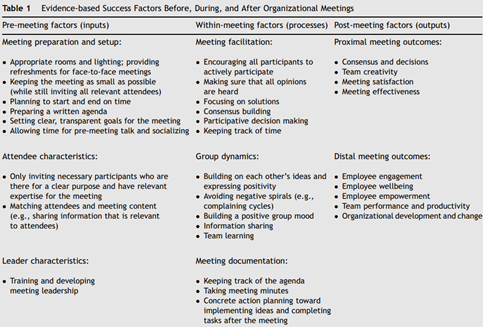
as well as those of Clarke (2003):
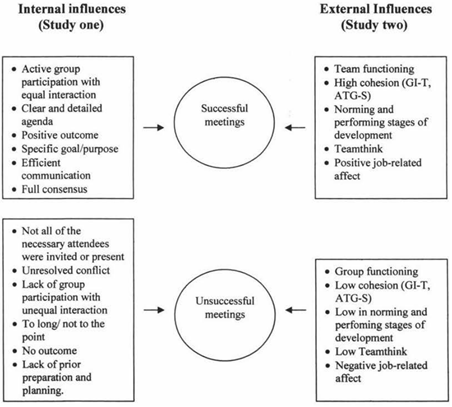
Finally, Geimer, Leach, DeSimone, Rogelberg and Warr (2015) propose a model that accounts for the motivation of teams to participate in a meeting:
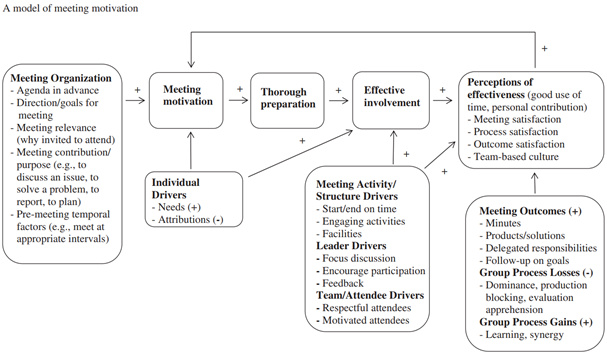
Read this article in other languages
Français : Organiser et animer une réunion de travail efficace : le guide ultime
Italiano: Come gestire una riunione di lavoro efficace: la guida definitiva


